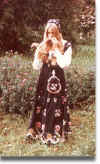Grafferbunad
(click on the picture to get a larger image)
|
|
 From Elise in
Ithaca, NY, USA, I got this picture and a nice letter: From Elise in
Ithaca, NY, USA, I got this picture and a nice letter:
"I have good memories of my first time seeing a bunad. My cousin Sonja in Hov i Land on Randsfjord let me try hers on when I was 12 (of course it just hung on me b/c i was so little then 30 years ago!). I felt so beautiful in it and like a princess or something. My father took this picture of me (1972) and it always reminds me of that experience. (Sonja was born and raised in Horten where all our family comes from, but I don't think her bunad is Vestfold)" And Elise is right, this is not Vestfoldbunad, but a
Grafferbunad. It is in the old traditional black color, today it is made
with a red brocade bodice. |
More about the Graffer Bunad
This bunad is based on an old blue skirt from the 18th
century, discovered at the Graffer Farm in Lom. The Graffer family and the Gudbrandsdalen Husflidsforening
[Gudbrandsdal Home Crafts Association] undertook to revise the costume and created the bunad as it looks
today.
After its first appearance in the 1930s, the Graffer bunad was worn with a number of different bodices, and then it won a new popularity when the revised costume was launched in 1952. Since then it has been the model for many other Norwegian bunads. The bodice for this bunad is still hand-sewn and so the traditional sewing technique has been preserved as part of the vital cultural inheritance from this region.
(From http://www.husfliden.no )